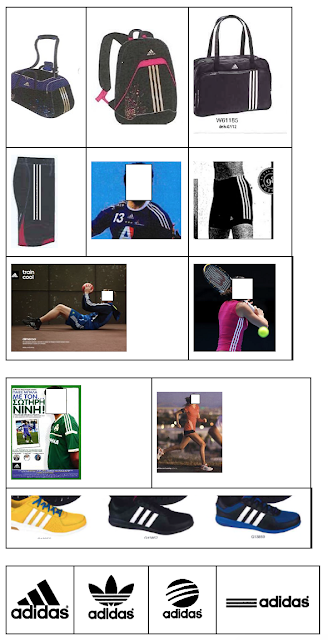

Three "Stripes" - and you are out - EU General Court cancels adidas 3-stripe mark
With its decision dated 19 June 2019, the European General Court (T-307/17) confirms invalidity of one of adidas’ three-stripe-marks, namely European Union Trademark Registration No. 12442166.
I. Background of the case
EU trademark No. 12442166, claiming protection for the below sign, was filed by the German company adidas AG as a figurative mark on 18 December 2013.
Although the company Shoe Branding Europe BVBA filed third party observations during the examination proceedings, in particular indicating that the sign is devoid of any distinctiveness and requesting the Office to reject the application in its entirety, the European Union Intellectual Property Office (EUIPO) registered the mark as a figurative mark on 21 May 2014 for the goods “clothing; footwear; headgear” in class 25 without official objections.
II. Proceedings before the EUIPO Cancellation Division and the Board of Appeal
On 16 December 2014, Shoe Branding Europe BVBA filed an application for a declaration of invalidity of the mark, claiming absolute grounds for invalidity. After several rounds of submissions, the EUIPO Cancellation Division issued a decision in the cancellation proceedings on 30 June 2016 and ruled that the request for a declaration of invalidity of EU Trademark No. 12442166 is successful in its entirety and the mark is invalidated for all the registered goods.
The Cancellation Division dealt comprehensively with the matter and outlined, inter alia, that it considered that the contested mark is likely to go unnoticed by most consumers or that it will not be perceived as a sign denoting a connection with a specific undertaking. In reaching this conclusion the Cancellation Division noted that the sign consists of “three normal black vertical equidistant lines”; even if the lines are noticed at all, it will - according to the EUIPO - not be perceived prima facie as a trademark. The EUIPO concluded that the contested mark is not inherently distinctive.
EUIPO then examined the evidence provided by adidas in support of a finding of acquired distinctiveness. Although adidas had invested much and filed a very high amount of evidence (around 12.000 pages), including market surveys conducted in all EU countries, supporting the argument that the three stripes have acquired distinctiveness due to its significant, high profile and intensive use which has been made throughout the EU, the EUIPO was not convinced. The Cancellation Division found that this evidence establishes without question that “adidas” is a worldwide brand name in relation to sports clothing, footwear and headgear. However, the EUIPO made it clear that the evidence provided in the present proceedings by adidas relating specifically to the contested mark is not sufficient for proving that the contested mark has acquired distinctiveness throughout the EU. According to the EUIPO, adidas has not made the connection between the imposing market share figures, turnover, advertising expenditure, and notoriety of the adidas brand on the one side and the exposure of the public to the contested mark on the other.
Adidas appealed the case arguing that the Cancellation Division had carried out an incomplete review of the evidence provided in support of the argument of acquired distinctiveness through use. The EUIPO Board of Appeal re-examined the Cancellation Division’s examination of the evidence filed by adidas and found that the accusation that the first instance had made an incomplete review is baseless. The Board of Appeal highlighted that the only sensible approach possible to deal with such a sheer volume of evidence to be analyzed was to illustrate global findings through the aid of selected exhibits. The Board of Appeal upheld the contested decision and ruled that the challenged EU trademark must be declared invalid.
III. The decision of the General Court (GC)
In addition, the decision of the GC also supports the position of the previous EUIPO instances.
Before the GC, adidas claimed that the EUIPO Board of Appeal had unduly dismissed evidence based on the ground that said evidence was related to signs other than the mark at issue.
According to adidas, the Board of Appeal both in particular misapplied the “law of permissible variations”, as it had considered several of the filed examples of alleged use of the challenged mark as having failed to show genuine use of the mark, i.e. the following examples:
During the proceedings before the GC, the EUIPO had assumed that “use” in connection with the concept of acquired distinctiveness of a mark through use is narrower than “genuine use” and that therefore, in order to establish that a trademark has acquired distinctive character, the trademark proprietor can only rely on the use of the mark such as it was registered and only insignificant changes can be accepted.
The GC acknowledged that the concept of acquired distinctiveness through use is based on the assumption that use of an inherently non-distinctive sign and of a trademark which has been erroneously registered despite its lack of distinctive character may in some cases allow that sign or mark to be registered or to remain registered, while the concept of “genuine use” has a legitimate registration at its starting point.
However, the Court nevertheless outlined that the fact remains that the need to make certain changes to a trademark for the purposes of its commercial exploitation is also valid for the period during which that mark acquired distinctive character following its use. Therefore, the GC highlighted that adidas rightly claimed that the concept of use of a trademark must be interpreted as referring not only to use of the mark in the form in which it was filed and, where, relevant, registered, but also to the use of the trademark in forms which differ from that form solely by insignificant variations and that are able to be regarded as broadly equivalent to that form.
Despite this finding, the GC confirmed the Board of Appeal’s view that most of the examples contained in the comprehensive evidence material including the above examples were related to signs other than the challenged mark (different color compositions, other proportion relations etc.), in particular based on the argument that, where a trademark is extremely simple, even minor alterations to that mark may constitute significant changes. The GC concluded that to infringement of the “law of permissible variations” had occurred.
The only evidence which was in view of the GC relevant were five (5) market surveys covering only five (5) EU Member States. This was deemed insufficient to prove acquired distinctiveness throughout the whole EU.
IV. Remarks
The GC’s decision should be taken seriously as it shows that the “law of permissible variations” is connected to strict criteria.
What we learn in addition: not every kind of use and evidence submitted may help your case. The trademark owners do not do themselves a favor when they overwhelm the Office or Court with a huge amount of evidence in the attempt of convincing them of the incredible well-known status and/or extensive use of a sign. The better approach seems to be carefully collecting evidence and selecting those pieces which have a convincing probative value. In this context, the present case joins the recent “Big Mac” case of the GC, where the filing of the wrong kind of (or poor) evidence was fatal for another arguably well-known trademark.
It remains to be seen whether adidas will bring the case to the last instance, the European Court of Justice (ECJ).
IMPORTANT: Adidas is, still the owner of several other three-stripe marks which are registered at the EUIPO and which are not affected by the current decision. Therefore, competitors must still be very careful when using any kinds of stripes for clothing, footwear etc.
For more information, please find the full decision here: http://curia.europa.eu/juris/document/document.jsf;jsessionid=2922D45D72B5CF54200EC1EF7F10CBFF?text=&docid=215208&pageIndex=0&doclang=EN&mode=lst&dir=&occ=first&part=1&cid=3682167.
Related
- "Neuschwanstein" is not a trademark!
- 1 December 2017: Madrid Monitor takes its place as the one and only tool for tracking international trademarks
- 1 January 2020 - Changes in Classifications - Trademarks, Designs, Patents and Utility Models
- 100th Anniversary of Bavaria (Germany) - A glance at trademarks, start-ups, innovation & events
- 10th Anniversary Edition - 10 Things to Know about LexDellmeier - Past, Present & Future
- 14 June 2013: Munich Patent Law Conference - Calculating Damages in Patent Infringement Cases
- 15 Top Brands - Interactive Brand Rating - Years 2000 - 2018
- 15 Years LexDellmeier - 2024 New Year Wishes
- 2014: Statistics for Community Trademarks
- 2024 World IP Day - Building Our Common Future with Innovation and Creativity

